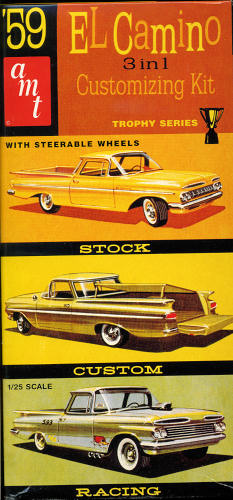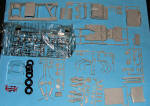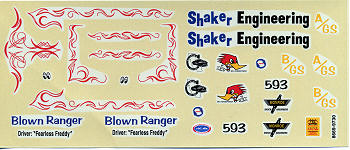 AMT 1/25
1959 Chevrolet El Camino
AMT 1/25
1959 Chevrolet El Camino
 AMT 1/25
1959 Chevrolet El Camino
AMT 1/25
1959 Chevrolet El Camino
| KIT #: | 8669 |
| PRICE: | $20.00 from the LHS |
| DECALS: | Several options |
| REVIEWER: | Scott Van Aken |
| NOTES: | 1997 issue |
| HISTORY |
The Chevrolet El Camino is a coupe utility vehicle produced by the Chevrolet division of General Motors for the 1959–1960 model years in response to the success of its rival, Ford Ranchero. Production resumed for the 1964–1977 model years based on the Chevelle platform, continuing for the 1978–1987 model years based on the Malibu. El Camino's literal Spanish meaning is "the road." Although based on corresponding Chevrolet car lines the vehicle is classified and titled in North America as a truck.
The first El Camino was produced for the 1959 model year two years after the Ford Ranchero's introduction. Chevrolet stylists had considered a new coupe pickup well before the Ranchero appeared; according to stylist Chuck Jordan, Harley Earl himself had suggested such a thing back in 1952. As was often becoming the case, though, it took Ford's example to convince Chevrolet to move, and Chevy's response to the Ranchero did not appear until 1959, just as Ford was preparing to shift gears. This was the year of the completely redesigned, longer, lower and wider full-sized Chevrolet. It sold in fewer numbers than the more conservatively styled Fords, but 22,246 El Caminos were sold, beating Ford's 14,169 Ranchero sales.
Like the Ranchero, it was based on an existing and modified platform, namely the new-for-1959 Brookwood two-door station wagon and corresponding sedan delivery variant; unlike those models, the El Camino was available with any trim level and drivetrain option corresponding to the car line, including that of the Chevrolet Impala. The El Camino was built on Chevy's 1959 passenger-car chassis that featured a "Safety-Girder" X-frame design and full-coil suspension, both of which had debuted on the 1958s. The 119-inch (3,000 mm) wheel-base was 1.5 inches (38 mm) longer than that of the 1958 models, though. Overall length for all 1959 Chevys was up to 210.9 inches (5,360 mm). The El Camino's payload rating ranged from 650 pounds to 1150 pounds, with gross vehicle weights ranging from 4400 to 4900 pounds, depending on powertrain and suspension options specified. The somewhat soft, passenger-car-type standard suspension enabled the El Camino to stand level without a load. (By contrast, the Ranchero came with stiffer heavy-duty rear springs that provided it with a standard 1100-pound payload rating and gave it a distinct "rake" when unloaded.) The quirky Level Air suspension option, in its second and final year, was listed as available, but was almost never seen on any Chevrolet model, much less an El Camino. The 1959 El Camino was promoted as the first Chevrolet pickup built with a steel bed floor instead of wood. The floor was a corrugated sheetmetal insert, secured with 26 recessed bolts. Concealed beneath it was the floor pan from the Brookwood two-door wagon, complete with foot wells. Box capacity was almost 33 cubic feet (0.93 m3).
The 283-cid Turbo-jet V8 with two- or four-barrel carburetion and several Turbo-Thrust 348-cid V-8s with four-barrel or triple two-barrel carbs (the latter with up to 335 bhp (250 kW; 340 PS) by mid 1959) were among the entrées. Even the 250- and 290-bhp 283-cube Ramjet Fuel Injection engines were available.
| THE KIT |
 This
is one of AMT's 'throwback' kits. These kits were boxed as they were in the late
1950s/early 1960s. Those boxes were such that once you got the parts out of the
box, there was NO WAY you'd ever be able to get them back in and have the box
close properly. I'm convinced that they hired elves to do the packaging as even
today, I can't get the lid to close all the way.
This
is one of AMT's 'throwback' kits. These kits were boxed as they were in the late
1950s/early 1960s. Those boxes were such that once you got the parts out of the
box, there was NO WAY you'd ever be able to get them back in and have the box
close properly. I'm convinced that they hired elves to do the packaging as even
today, I can't get the lid to close all the way.
Anyway, these were true 3 in 1 kits where one could build the car stock, custom or racing. Included in the box are all the bits to do so, with the racing version having a blown Cadillac engine and large drag slicks. Custom version has some additional interior bits, a bed cover and different grille and tail lights.
AMT kits of the time were fairly well done, though the detail is considerably 'softer' than what modelers demand today. Crisp is not the word one uses to describe the molding of the parts. This lack of clarity is one reason that Revell-Monogram kits are preferred by many of today's model car builder if both companies mold the same car.
In addition to having a full engine, this particular kit has steerable front wheels. The king pins have three different holes for the front axle stubs so that one can do the custom or racing car with the front wheels either raised or lowered from the stock position. This option is not repeated for the rear end, where one has a full rear suspension with drive shaft. Of course, one has the option of stock, custom or racing wheels as well. In the latter option, it is basically just the stock wheel without a wheel cover.
 As mentioned,
there are optional bits for the interior as well as a bed cover for the custom
version. The tail gate is a separate piece and is hinged so it can be posed in
the open position.
As mentioned,
there are optional bits for the interior as well as a bed cover for the custom
version. The tail gate is a separate piece and is hinged so it can be posed in
the open position.
Instructions are the long, fold-up type that was used back in the 60s. A nice decal sheet is included but has yellowed. The decals from AMT have always been rather thick and despite the yellowing of the backing, the decals themselves may well prove to be useful, assuming the glue hasn't undergone some sort of chemical change over the years.
| CONCLUSIONS |
Though I'm sure this isn't everyone's cup of tea, it is the only '59 El Camino of which I'm aware so fans of the type will have to use this one. It should make into a very nice and probably larger than you'd think car model.
| REFERENCES |
http://en.wikipedia.org/wiki/Chevrolet_El_Camino
January 2011 Thanks to
me for this one. If you would like your product reviewed fairly and quickly, please
contact
me or see other details in the
Note to
Contributors.